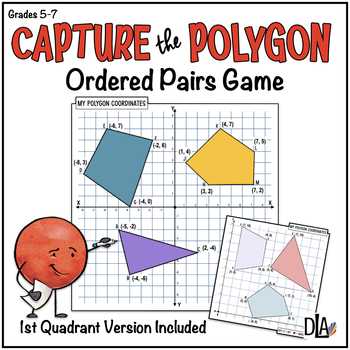Ordered Pairs-Coordinate Plane Battleship Game - Capture the Polygon
- PDF
Also included in
- This engaging ordered pairs bundle brings the best of the coordinate plane, ordered pairs, and polygons together in one easy-to-use bundle. Whether you're looking for math stations, sub day activities, homework practice or Plan B, this bundle will meet your needs!© Pamela Kranz Desktop Learning AdvePrice $9.75Original Price $12.25Save $2.50
Description
Capture the Polygon is a Battleship-like strategy game. Played on the coordinate plane, students must use their best problem-solving strategies to capture all of their opponent's polygons.
This vocabulary-rich game encourages students to apply their knowledge of the coordinate plane and graphing ordered pairs to name polygons.
Set up is easy. Just print and play.
What's Included?
- Complete Teacher Notes and instructions with a Quick Set Up Guide
- Two Game Versions: 1st Quadrant and the complete Cartesian Plane
- Teacher Sample Game in each version
- Student game boards - one for each version
- Six additional 1st Quadrant game boards for students that need some extra support
Best Uses:
- Early Finishers
- Sub Days
- Extra Practice
- The Problem of the Week
- On-Going Warm Up
- Before or After Assessments
© Pamela Kranz Desktop Learning Adventures
***************************************************************************
Customer Tips:
How to get TpT credit to use on future purchases:
Please go to your My Purchases page (you may need to log in). Beside each purchase, you'll see a Provide Feedback button. Simply click it, and you will be taken to a page where you can give a quick rating and leave a short comment about the product. Each time you give feedback, TpT gives you feedback credits that you use to lower the cost of your future purchases. I value your feedback greatly, as it helps me determine which products are most valuable for your classroom, so I can create more for you.
Be the first to know about my new discounts, freebies, and product launches:
Look for the green star next to my store logo and click it to become a follower.Voila! You will now receive email updates about this store!
Thanks for stopping by! Pam Kranz
***************************************************************************






